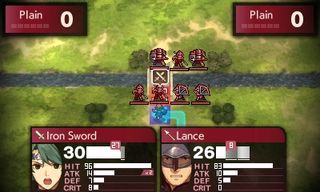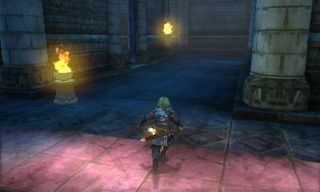What's old is new again in Fire Emblem Echoes: Shadows of Valentia

Whether you first jumped into the famed Fire Emblem series with Awakening, or you've been fighting its battles for decades, Fire Emblem Echoes: Shadows of Valentia has something new to show you. This 3DS revamp follows the same overarching story and basic mechanics as the Japan-exclusive sequel Fire Emblem Gaiden for the Famicom - but this isn't a 1:1 remake of the second game in the entire series. Rather, SoV blends the gorgeous anime art style and pristine presentation of modern Fire Emblem with the more old-school tactics and freeform exploration of Gaiden to create something that only feels familiar at a surface level. Though it's based on a known quantity, SoV manages to break new ground for Fire Emblem with some welcome additions - you just might need to take a few lumps before you find your strategic groove.
The continent of Valentia is divided by conflict, and our two protagonists Alm and Celica aim to fix all that, even if they need to dish out some hurt to ultimately restore peace. You'll play as both leaders, each commanding their own armies, as you fight your way across Valentia's sprawling map. If you've watched SoV's story trailer, you'll also know that legends of the gods Duma and Mila also factor into the plot, though it's unclear just how big of a (possibly physical) presence they are in the world. With the story stakes set, you can jump right into the familiar turn-based skirmishes as you move your units around a grid-lined battlefield and set up tactical fronts. But if you're more familiar with recent entries in the series, like Fire Emblem Fates or Fire Emblem Awakening, you might initially be taken aback by how SoV adheres to Gaiden's simpler sensibilities.
For starters, you won't find the time-honored, rock-paper-scissors-style weapon triangle of sword, axe, and lance here. You also won't find the traditional support system that lets you pair up your forces, be it during combat or downtime; romantic relationships and raising children aren't a factor in SoV. Rather, the tactical options at your disposal are more traditional: optimizing the attack range and positioning of your units, and it's crucial that you utilize the surrounding terrain as best you can. Mages use up HP rather than spend SP when casting magic, so every offensive spell comes with a drawback to their wellbeing. Fatigue, a status only seen in Fire Emblem: Thracia 776 previously, penalizes you for using the same fighters too often; you'll have to restore their spirits (represented by a little smiley-face) by gifting them items or making offerings to a sacred statue of Mila. With so much minutiae to keep track of, it might all be a little more hardcore than what newer Fire Emblem fans have come to expect.

That's not to say they should feel intimidated, though - you can still tailor the game to be more forgiving or punishing as you see fit. You've still got the option between Classic and Casual play (the former with unit permadeath, the latter without), as well as Normal and Hard modes to give you the appropriate challenge across the campaign. And even though you won't be wooing any waifus or husbandos within your forces, there's still a relationship-building aspect in the form of friendly chats during fights. It's unclear if strengthening these platonic bonds has a passive effect like increased crit rate, or simply helps to provide backstory and give you extra emotional incentive to keep fighters alive, but in any case, these exchanges are still oozing Fire Emblem's distinct brand of medieval anime charm.

Speaking of, every aspect of SoV's overall presentation shined during my 40 minutes of hands-on with the game. Combat vignettes where the camera swoops down into a one-on-one clash look great (and the fights are reportedly packed with subtle animations for each unit type, like a mounted horse bucking after an archer flings an arrow at it). The soundtrack includes stirring orchestral covers of Gaiden's original chiptunes. Studio Khara is once again animating the stylish cutscenes, and all the character art is as appealing as ever. Best of all, voicework has been massively expanded for SoV; though it's not 100% voiced, the majority of the myriad conversations across the main storyline and plentiful side missions are acted out with full English dialogue. It does wonders for helping flesh out the minor characters, instantly infusing even more personality into each quip and encouraging battlecry. Though SoV doesn't incorporate support courtships, doesn't mean there can't be some sexual tension; for instance, Alm's childhood friend Faye is seriously crushing on him, flirtatiously professing to him "I'll fight for any cause you desire - just promise you'll be watching, Alm. Promise to look at me!"
Faye is a character who never appeared in Gaiden, showing off SoV's willingness to expand the storyline with additional companions with their own trials and tribulations. Another new element in Alm and Celica's story - and the Fire Emblem franchise as a whole - is the incorporation of dungeons explored in third-person, action-adventure style. In the campaign's second dungeon, Alm pokes around the hideout of a counter-revolutionary group called The Deliverance, who are fighting back against the people who enacted a coup opposing Valentia's king. It just so happens that they set up camp in a temple where Terrors (read: rotting undead) roam free, so Alm and his dungeon party (with a max of 10 people per team) have to clear house.

Braving a dungeon's depths in third-person is an unfamiliar but refreshing sensation in a Fire Emblem game, and all the battles themselves still take place in the traditional, top-down, tactical form. As you guide Alm or Celica around (with the option to rotate the camera with the C-Stick on a New 3DS), you can tap A to perform a quick slash attack, or hold B to dash around. Hitting everything in sight is advantageous: striking an enemy before they make contact will give you a preemptive offense in the ensuing encounter, breaking the many crates, pots, and barrels lying around may reveal coins (a bonus atop the simple satisfaction of destroying things), and you can even knock down some walls to reveal hidden passages after a few hits. With dashing, you could ostensibly avoid fights entirely with nimble movement, grabbing the contents of treasure chests without slaying the nearby Terrors - but dungeons are the ideal place to grind out a level or two, as the enemies will all respawn once you exit to the outside world.
Sign up to the GamesRadar+ Newsletter
Weekly digests, tales from the communities you love, and more
One last bit of obvious newness grafted onto Gaiden's basic structure is the addition of amiibo functionality. By tapping in the Alm or Celica amiibo, you'll spend 10 HP to summon them as an illusory ally that'll attack (and hopefully obliterate) the opposition on the next turn, outside of your direct control. Incorporating amiibo is just one of the many ways Fire Emblem Echoes: Shadows of Valentia modernizes the story of Fire Emblem Gaiden, but it adheres to the original's systems in a way that should surprise and challenge players of all skill and experience levels. You'll get the chance to command Alm and Celica's armies when Shadows of Valentia launches for 3DS on May 19th.
Lucas Sullivan is the former US Managing Editor of GamesRadar+. Lucas spent seven years working for GR, starting as an Associate Editor in 2012 before climbing the ranks. He left us in 2019 to pursue a career path on the other side of the fence, joining 2K Games as a Global Content Manager. Lucas doesn't get to write about games like Borderlands and Mafia anymore, but he does get to help make and market them.
Most Popular




